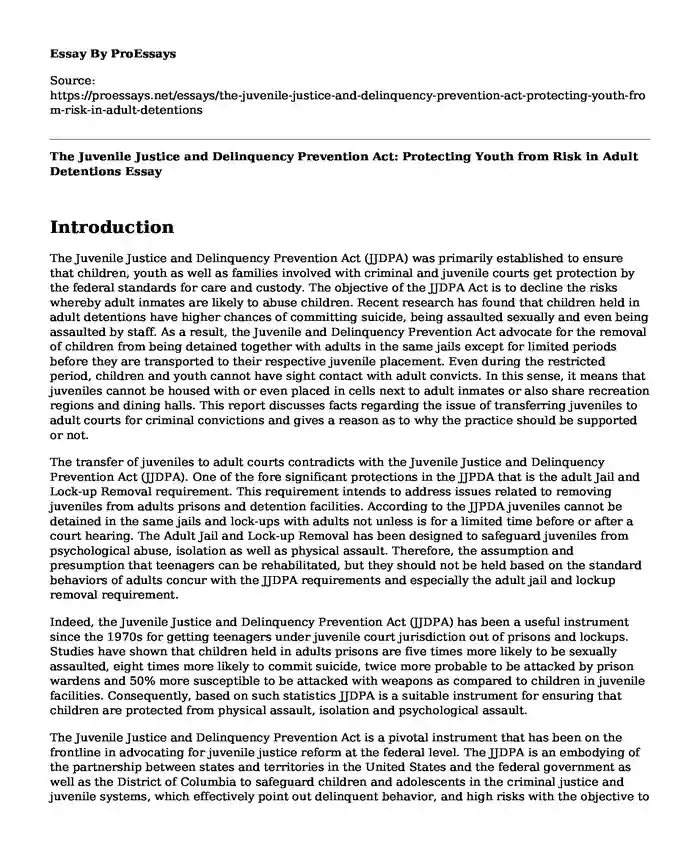Introduction
The Juvenile Justice and Delinquency Prevention Act (JJDPA) was primarily established to ensure that children, youth as well as families involved with criminal and juvenile courts get protection by the federal standards for care and custody. The objective of the JJDPA Act is to decline the risks whereby adult inmates are likely to abuse children. Recent research has found that children held in adult detentions have higher chances of committing suicide, being assaulted sexually and even being assaulted by staff. As a result, the Juvenile and Delinquency Prevention Act advocate for the removal of children from being detained together with adults in the same jails except for limited periods before they are transported to their respective juvenile placement. Even during the restricted period, children and youth cannot have sight contact with adult convicts. In this sense, it means that juveniles cannot be housed with or even placed in cells next to adult inmates or also share recreation regions and dining halls. This report discusses facts regarding the issue of transferring juveniles to adult courts for criminal convictions and gives a reason as to why the practice should be supported or not.
The transfer of juveniles to adult courts contradicts with the Juvenile Justice and Delinquency Prevention Act (JJDPA). One of the fore significant protections in the JJPDA that is the adult Jail and Lock-up Removal requirement. This requirement intends to address issues related to removing juveniles from adults prisons and detention facilities. According to the JJPDA juveniles cannot be detained in the same jails and lock-ups with adults not unless is for a limited time before or after a court hearing. The Adult Jail and Lock-up Removal has been designed to safeguard juveniles from psychological abuse, isolation as well as physical assault. Therefore, the assumption and presumption that teenagers can be rehabilitated, but they should not be held based on the standard behaviors of adults concur with the JJDPA requirements and especially the adult jail and lockup removal requirement.
Indeed, the Juvenile Justice and Delinquency Prevention Act (JJDPA) has been a useful instrument since the 1970s for getting teenagers under juvenile court jurisdiction out of prisons and lockups. Studies have shown that children held in adults prisons are five times more likely to be sexually assaulted, eight times more likely to commit suicide, twice more probable to be attacked by prison wardens and 50% more susceptible to be attacked with weapons as compared to children in juvenile facilities. Consequently, based on such statistics JJDPA is a suitable instrument for ensuring that children are protected from physical assault, isolation and psychological assault.
The Juvenile Justice and Delinquency Prevention Act is a pivotal instrument that has been on the frontline in advocating for juvenile justice reform at the federal level. The JJDPA is an embodying of the partnership between states and territories in the United States and the federal government as well as the District of Columbia to safeguard children and adolescents in the criminal justice and juvenile systems, which effectively point out delinquent behavior, and high risks with the objective to improve the safety of the community. Indeed, the Juvenile Justice and Delinquency Protection Act stand as the only federal legislation, which sets out national standards for the care and custody of teenagers in the juvenile justice system. As a result, JJDPA is tasked with the mandate to give support and direction for state juvenile justice system improvements through the help of programs and practices, which have effectively, contribute to the decline of juvenile delinquency and crime. Accordingly, JJDPA has been a significant milestone in the juvenile justice system in the sense that its original intention was to recognize the unique requirements facing children and youths in the criminal justice system. In this sense, JJDPA has established a separate criminal justice system that mainly addresses children needs. Among the unique needs addressed by JJDPA is to protect children from dangers in the adults' prisons.
References
Juvenile Justice. (2019). Adult Jail and Lock-up Removal | CJJ. Retrieved from https://www.juvjustice.org/juvenile-justice-and-delinquency-prevention-act/adult-jail-and-lock-removal
Lehmann, P. S., Chiricos, T., & Bales, W. D. (2017). Sentencing transferred juveniles in the adult criminal court: The direct and interactive effects of race and ethnicity. Youth violence and juvenile justice, 15(2), 172-190.
Cite this page
The Juvenile Justice and Delinquency Prevention Act: Protecting Youth from Risk in Adult Detentions. (2023, Jan 12). Retrieved from https://proessays.net/essays/the-juvenile-justice-and-delinquency-prevention-act-protecting-youth-from-risk-in-adult-detentions
If you are the original author of this essay and no longer wish to have it published on the ProEssays website, please click below to request its removal:
- Task Force on Private Security Paper Example
- Significant Problems That Transgender Face in the Criminal Justice System
- Essay Example on America's Healthcare Dilemma: Too Much Profit or Too Much Cost?
- Essay Sample on Net Neutrality & Criminal Justice: Examining Access to Justice in an Information World
- Essay Example on Female Terrorists: Breaking the Stereotype
- Organized Crime: Criminal Organizations, Terrorist Groups, and Militias - Essay Sample
- Supreme Court Justices - Free Essay Sample







